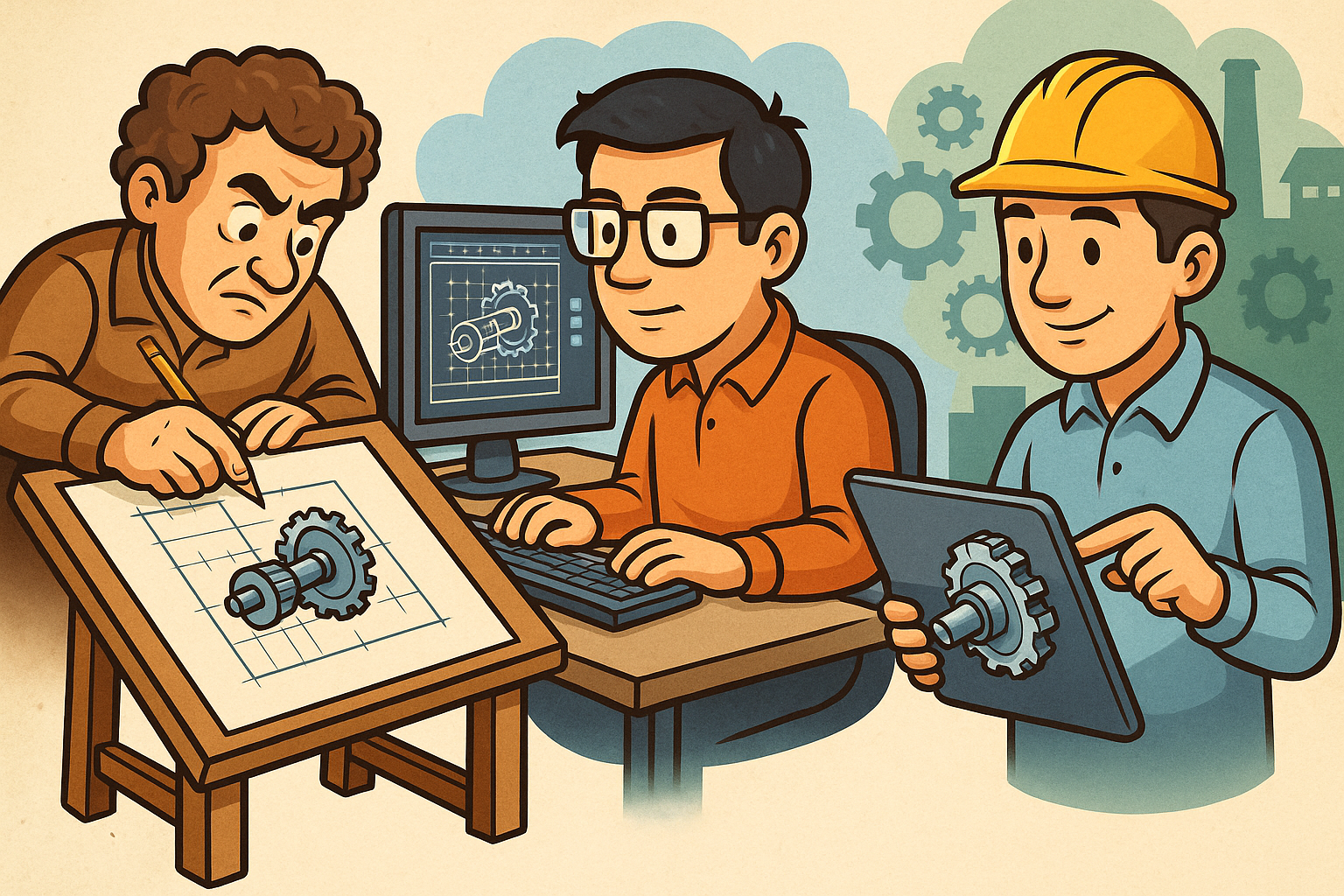Your Cart is Empty
Customer Testimonials
-
"Great customer service. The folks at Novedge were super helpful in navigating a somewhat complicated order including software upgrades and serial numbers in various stages of inactivity. They were friendly and helpful throughout the process.."
Ruben Ruckmark
"Quick & very helpful. We have been using Novedge for years and are very happy with their quick service when we need to make a purchase and excellent support resolving any issues."
Will Woodson
"Scott is the best. He reminds me about subscriptions dates, guides me in the correct direction for updates. He always responds promptly to me. He is literally the reason I continue to work with Novedge and will do so in the future."
Edward Mchugh
"Calvin Lok is “the man”. After my purchase of Sketchup 2021, he called me and provided step-by-step instructions to ease me through difficulties I was having with the setup of my new software."
Mike Borzage
Design Software History: Historical Evolution of Design Software in Mechanical Engineering: From Manual Drafting to Digital Integration and its Impact on Education and Industry
July 25, 2025 9 min read


Historical Context and Foundational Era of Mechanical Engineering Education
Mechanical engineering education in the pre-digital era was built upon a strong foundation of hands-on practice, emphasizing rigorous manual techniques and technical drawing skills that were essential for design and innovation. In this foundational period, engineering students were immersed in a world where the precision of hand-drawn sketches and physical models reigned supreme. This approach demanded that students develop exceptional drafting skills with rudimentary tools such as pencils, compasses, and drafting boards. Workshops and laboratories were filled with blueprints and sketches that conveyed complex geometries by human interpretation, and every line was drawn with meticulous care. The absence of digital aids meant that each design process was steeped in tradition, an era defined by a direct relationship between the engineer and the physical medium. The challenges of technical drawing not only set high standards for accuracy but also required that young designers possess a deep understanding of spatial relationships and geometric fundamentals.
Emphasis on Manual Precision and Traditional Techniques
The intrinsic commitment to manual precision was evident in every aspect of engineering education during this era, as students learned to translate innovative ideas into tangible outcomes through painstaking methods. Within the academic environment, traditional drawing techniques were taught by master draftsmen and experienced engineers who emphasized continuous practice and iterative refinement. The challenges were plentiful: engineers had to work with instruments that were intrinsically limited by human dexterity and the physical constraints of the available tools. Furthermore, there was a distinct cultural emphasis on the quality of craftsmanship, which was seen not only as a skill but also as a measure of an engineer’s dedication and attention to detail. The very notion of creativity in design was intertwined with the ability to manually produce a flawless visual representation of one’s ideas. Notably, this period established the fundamental importance of accuracy in design that would later inform the transition to digital methods, marking the onset of a gradual integration of technology into engineering academia.
The Initial Convergence Toward Digital Integration
As the 20th century advanced, a slow but steady convergence towards computer-assisted design began to reshape engineering education, setting the stage for the incorporation of digital methodologies into academic curriculums. While the traditional approach continued to dominate many engineering schools, there was growing recognition among educators of the need to augment manual drawing skills with emerging digital tools. As early innovators started experimenting with computer-aided design (CAD) systems, the potential to bridge the gap between traditional techniques and modern computational power became increasingly evident. The progressive migration into academia was driven by a desire to enhance accuracy, speed, and the ability to simulate complex designs that were difficult, if not impossible, to capture by hand. This era not only highlighted the challenges of sustaining legacy techniques in an increasingly digital world but also ignited a fervent interest among students and faculty alike to embrace groundbreaking technological solutions. In this transformative period, the initial steps toward a digital revolution in design were carefully weighed against the time-honored traditions of manual engineering, planting the seeds for what would evolve into a robust, hybrid learning environment.
Evolution of Design Software in Mechanical Engineering
The evolution of design software in mechanical engineering is a story of technological breakthroughs, innovative thinking, and the relentless pursuit of efficiency. In the nascent stages of computer-aided design, primitive software applications primarily served as digital drafting tools, providing engineers an electronic alternative to hand-drawing. These early systems were characterized by their basic functionalities, which allowed users to create and modify simple geometrical shapes on the screen. Despite their limited capabilities, these applications represented a quantum leap from traditional techniques, enabling a level of precision and reproducibility that had previously been unattainable. Over time, key technological milestones such as the advent of vector-based graphics, interactive design interfaces, and the incorporation of simulation engines transformed this primitive drafting environment into comprehensive environments for simulation and analysis.
Key Technological Milestones and Innovative Breakthroughs
Among the most significant breakthroughs were the advent of early computer-aided design (CAD) systems in the 1960s and 1970s, which enabled the generation of accurate digital sketches and the execution of complex calculations in real time. These systems laid the groundwork for modern design software by demonstrating that computers could effectively assume roles traditionally filled by manual labor and artistic skill. Important innovations such as the development of wireframe modeling, surface modeling, and solid modeling expanded the range of design possibilities. In addition to these technical milestones, new graphical user interfaces and intuitive input devices bridged the gap between the user and the machine, making the technology accessible to a wider range of engineers. The evolution of design software continued with the integration of simulation and analysis capabilities, giving rise to systems that could not only represent a design visually but also predict real-world performance under stress, vibration, and varied operating conditions. As engineers and researchers pushed the boundaries of computational modeling, design software became a complex tool invaluable for prototyping and engineering validations.
Influential Companies and Pioneering Innovators
Several companies and innovators played pivotal roles in shaping the trajectory of design software development. Autodesk emerged as a leader by developing groundbreaking CAD software that integrated computer-aided drafting into everyday engineering practice. Similarly, PTC demonstrated forward-thinking strategies by merging design and simulation functionalities into a cohesive system, paving the way for what would become an industry standard. Alongside these commercial enterprises, early academic pioneers recognized the potential of digital design, using in-house developed tools to complement the traditional curriculum. Bulleted points outlining their contributions include:
- Innovation in User Interfaces: Early emphasis on developing intuitive and user-friendly interfaces that bridged user needs with computational power.
- Advancements in Solid Modeling: Pioneering techniques that allowed for precise three-dimensional representations of complex systems.
- Integration of Analysis Tools: Early efforts to incorporate simulation modules into design software, which enabled the prediction of real-world performance.
- Collaborative Development: Frequent partnerships between academia and industry ensured that theoretical advances were rapidly translated into practical applications.
Evolving Integration: From Drafting to Simulation
The evolution has not merely been a linear progression but has involved a multidimensional enrichment of design software. Early systems were essentially digital drafting boards; however, as the technology matured, they became platforms for fully integrated simulation environments. This transformation was characterized by embedding finite element analysis (FEA) and computational fluid dynamics (CFD) directly into design workflows, thereby streamlining the process from conceptual design to performance evaluation. Engineers no longer needed to rely on separate programs to run simulations or stress tests—modern design software could handle multiple tasks in a singular, unified interface. This convergence not only reduced errors inherent in data translation between disparate software packages but also accelerated the design iteration process significantly. Furthermore, by merging design and simulation, these platforms empowered engineers with the ability to predict product behavior under various conditions, substantially reducing the risk and resource implications of physical prototyping. Today’s design software owes its robustness to decades of incremental improvements built upon these early innovations, and it continues to evolve in response to ever-greater demands for precision, efficiency, and reliability.
Impact on Curriculum and Pedagogy in Mechanical Engineering
The integration of advanced design software into mechanical engineering has fundamentally reshaped curriculum and pedagogy. Traditional teaching methods, which once prioritized manual sketching and physical model building, have been augmented or even replaced by digital methodologies that reflect the modern realities of the engineering workforce. Educators are increasingly leveraging state-of-the-art design platforms to teach complex concepts in geometry, simulation, and computational analysis. This educational shift has facilitated a more interactive learning environment, as students now have the capacity to visualize intricate mechanical systems in three dimensions and simulate their real-world functioning. By incorporating digital tools, the learning process has become dynamic and iterative, encouraging students to engage in continuous improvement of their design projects. The engagement with digital design software has also fostered interdisciplinary connections, inviting collaboration with fields such as computer science, materials engineering, and industrial design, thus enriching the overall educational experience.
Transformation in Classroom Practices and Learning Methodologies
This pedagogical transformation has led to a significant departure from conventional, lecture-based learning. Modern engineering classrooms are now characterized by hands-on sessions where theoretical principles are immediately applied using digital design tools. The process typically involves interactive sessions where instructors guide students through the development of virtual prototypes, ensuring that every design decision is informed by both theoretical knowledge and practical constraints. Instructors now place greater emphasis on problem-based learning, where students work on realistic engineering problems in teams, simulating real-world engineering challenges. This approach cultivates critical thinking and teamwork, skills that are essential in contemporary engineering practice. Moreover, the use of design software in education has democratized access to complex computational tools, thereby enabling a broader range of students to engage with advanced engineering simulations and modeling activities. This evolution in teaching practices not only enhances the learning curve but also aligns academic experiences with industry demands, ensuring that graduates are better equipped to contribute meaningful innovations once they enter the professional sphere.
Fostering Interdisciplinary Skills and Prototype Development
The incorporation of digital design tools into engineering curricula has opened avenues for interdisciplinary learning and innovative project-based assignments. Students are encouraged to integrate ideas from various fields to develop more robust and versatile designs. The new paradigm of learning emphasizes iterative development processes, where initial conceptual designs are refined through critical feedback and successive enhancements. In this context, design software acts as a bridge connecting foundational theories with practical applications. Additionally, students gain invaluable experience in prototype development as they are tasked with creating virtual models that can be tested and evaluated under simulated conditions. This comprehensive educational approach not only builds technical acumen but also prepares students for the collaborative and multifaceted nature of industrial research and development. It has become evident that the infusion of digital tools into the curriculum is fostering an environment where innovation, creativity, and rigorous technical analysis coalesce, thereby redefining the future of engineering education.
Conclusion – Future Trends and Final Thoughts on Design Software Evolution
In reviewing the historical evolution of design software and its profound impact on mechanical engineering education, it becomes clear that digital tools have catalyzed transformative changes in both pedagogy and professional practice. The journey from manual drafting methods to advanced simulation platforms has not only made design processes more efficient and precise but has also expanded the horizon of what is achievable in modern engineering. This evolution is underscored by the contributions of influential companies and visionary innovators who have relentlessly pushed technological boundaries, ultimately empowering educators and students alike to embrace a more interconnected and dynamic approach to engineering design. As engineers continue to navigate the challenges of the modern world, balancing traditional engineering fundamentals with cutting-edge digital innovations will remain crucial.
Emerging Technologies and Their Educational Impact
Looking towards the future, emerging technologies such as cloud-based design tools, artificial intelligence, and virtual reality are poised to redefine the educational landscape even further. Cloud-based solutions are making collaboration simpler and more efficient by enabling real-time sharing and remote access to design platforms. These tools facilitate global collaboration and enhanced project management, ensuring that students and educators can work together seamlessly regardless of geographical constraints. Meanwhile, artificial intelligence is beginning to play a significant role in automating routine design tasks and optimizing engineering calculations, thereby allowing students to focus more on creative problem-solving. Virtual reality, on the other hand, offers immersive learning experiences that simulate real-world environments, making it possible for students to virtually enter and interact with their designs. By incorporating these cutting-edge tools into academic curricula, educational institutions can offer a more engaging and future-oriented learning experience. This proactive adoption of emerging technologies will continue to narrow the gap between academic training and industry standards.
Balancing Tradition with Innovation in Future Curricula
As the field of mechanical engineering evolves, educators and industry professionals must remain committed to preserving the core principles of sound engineering while embracing new software innovations. This delicate balance ensures that the foundational understanding of geometry, physics, and material behavior is never lost, even as digital design tools evolve to offer incredible levels of sophistication and interactivity. It is imperative to integrate the best of both worlds: the precise, time-tested techniques that defined the pre-digital era, and the innovative, computational methods that drive today’s design processes. To achieve this balance, academic institutions are increasingly adopting curricula that emphasize not only the functionality of design software but also the underlying engineering principles that inform its usage. This dual approach will prepare future engineers to think critically and creatively, ensuring that they are well-equipped to tackle complex challenges and drive forward the next wave of technological advancement.
Also in Design News

Cinema 4D Tip: Weight Manager Workflow for Fast, Stable Character Skinning
January 06, 2026 2 min read
Read More
Revit Tip: Purge Unused Families and Types to Optimize Revit Models
January 06, 2026 2 min read
Read MoreSubscribe
Sign up to get the latest on sales, new releases and more …



